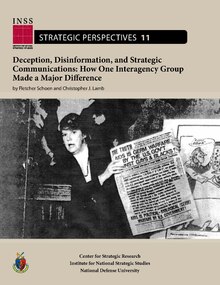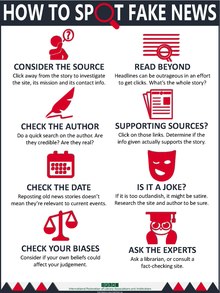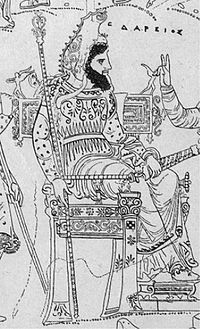Disinformation is a subset of propaganda and is false information that is spread deliberately to deceive. It is also known as black propaganda. It is sometimes confused with misinformation, which is false information but is not deliberate.
The English word disinformation is from the application of the latin prefix dis- to information making the meaning "reversal or removal of information". The rarely used word had appeared with this usage in print at least as far back as 1887. Some consider it a loan translation of The Russian dezinformatsiya, derived from the title of a KGB black propaganda department. Defector Ion Mihai Pacepa claimed Joseph Stalin coined the term, giving it a French-sounding name to claim it had a Western origin. Russian use began with a "special disinformation office" in 1923. Disinformation was defined in Great Soviet Encyclopedia (1952) as "false information with the intention to deceive public opinion". Operation INFEKTION was a Soviet disinformation campaign to influence opinion that the U.S. invented AIDS. The U.S. did not actively counter disinformation until 1980, when a fake document reported that the U.S. supported apartheid.
The word disinformation did not appear in English dictionaries until 1939. English use increased in 1986, after revelations that the Reagan Administration engaged in disinformation against Libyan leader Muammar Gaddafi. By 1990, it was pervasive in U.S. politics; and by 2001 referred generally to lying and propaganda.
Etymology and early usage
The English word disinformation, which did not appear in dictionaries until the late 1980s, is a translation of the Russian дезинформация, transliterated as dezinformatsiya. Where misinformation refers to inaccuracies that stem from error, disinformation is a deliberate falsehood promulgated by design. Misinformation can be used to create disinformation when known misinformation is purposefully and intentionally disseminated. The tactic has been used throughout history, being deployed during the long Roman-Persian Wars, at the Battle of Mount Gindarus, the Battle of Telephis–Ollaria, and Heraclius assault on Persia,for instance.
Disinformation is primarily carried out by government intelligence agencies, but has also been used by non-governmental organizations and businesses. Front groups are a form of disinformation, as they mislead the public about their true objectives and who their controllers are. Most recently, disinformation has been deliberately spread through social media in the form of "fake news", disinformation masked as legitimate news articles and meant to mislead readers or viewers. Disinformation may include distribution of forged documents, manuscripts, and photographs, or spreading dangerous rumours and fabricated intelligence. Use of these tactics can lead to blowback, however, causing such unintended consequences such as defamation lawsuits or damage to the dis-informer's reputation.
Use of the term related to a Russian tactical weapon started in 1923, when the deputy chairman of the KGB-precursor the State Political Directorate (GPU), Józef Unszlicht, called for the foundation of "a special disinformation office to conduct active intelligence operations". The GPU was the first organization in the Soviet Union to use the term disinformation for their intelligence tactics. William Safire wrote in his 1993 book, Quoth the Maven, that disinformation was used by the KGB predecessor to indicate: "manipulation of a nation's intelligence system through the injection of credible, but misleading data". From this point on, disinformation became a tactic used in the Soviet political warfare called active measures. Active measures were a crucial part of Soviet intelligence strategy involving forgery as covert operation, subversion, and media manipulation. The 2003 encyclopedia Propaganda and Mass Persuasion states that disinformation came from dezinformatsia, a term used by the Russian black propaganda unit known as Service A that referred to active measures. The term was used in 1939, related to a "German Disinformation Service". The 1991 edition of The Merriam-Webster New Book of Word Histories defines disinformation as a probable translation of the Russian dezinformatsiya. This dictionary notes that it was possible the English version of the word and the Russian-language version developed independently in parallel to each other—out of ongoing frustration related to the spread of propaganda before World War II.
Ion Mihai Pacepa, former senior official from the Romanian secret police, said the word was coined by Joseph Stalin and used during World War II. The Stalinist government then used disinformation tactics in both World War II and the Cold War. Soviet intelligence used the term maskirovka (Russian military deception) to refer to a combination of tactics including disinformation, simulation, camouflage, and concealment. Pacepa and Ronald J. Rychlak authored a book entitled Disinformation, in which Pacepa wrote that Stalin gave the tactic a French-sounding title in order to put forth the ruse that it was a technique used by the Western world. Pacepa recounted reading Soviet instruction manuals while working as an intelligence officer, that characterized disinformation as a strategy used by the Russian government that had early origins in Russian history. Pacepa recalled that the Soviet manuals said the origins of disinformation stemmed from phony towns constructed by Grigory Potyomkin in Crimea to wow Catherine the Great during her 1783 journey to the region—subsequently referred to as Potemkin villages.
In their book Propaganda and Persuasion, authors Garth Jowett and Victoria O'Donnell characterized disinformation as a cognate from dezinformatsia, and was developed from the same name given to a KGB black propaganda department. The black propaganda division was reported to have formed in 1955 and was referred to as the Dezinformatsiya agency. Former Central Intelligence Agency (CIA) director William Colby explained how the Dezinformatsiya agency operated, saying that it would place a false article in a left-leaning newspaper. The fraudulent tale would make its way to a Communist periodical, before eventually being published by a Soviet newspaper, which would say its sources were undisclosed individuals. By this process a falsehood was globally proliferated as a legitimate piece of reporting.
According to Oxford Dictionaries the English word disinformation, as translated from the Russian disinformatsiya, began to see use in the 1950s. The term disinformation began to see wider use as a form of Soviet tradecraft, defined in the 1952 official Great Soviet Encyclopedia as "the dissemination (in the press, radio, etc.) of false information with the intention to deceive public opinion." During the most-active period of the Cold War, from 1945 to 1989, the tactic was used by multiple intelligence agencies including the Soviet KGB, British Secret Intelligence Service, and the American CIA. The word disinformation saw increased usage in the 1960s and wider purveyance by the 1980s. A major disinformation effort in 1964, Operation Neptune, was designed by the Czechoslovak secret service, the StB, to defame West European politicians as former Nazi collaborators. Former Soviet bloc intelligence officer Ladislav Bittman, the first disinformation practitioner to publicly defect to the West, described the official definition as different from the practice: "The interpretation is slightly distorted because public opinion is only one of the potential targets. Many disinformation games are designed only to manipulate the decision-making elite, and receive no publicity." Bittman was deputy chief of the Disinformation Department of the Czechoslovak Intelligence Service, and testified before the United States Congress on his knowledge of disinformation in 1980.
Defections reveal covert operations
The extent of Soviet disinformation covert operation campaigns came to light through the defections of KGB officers and officers of allied Soviet bloc services from the late 1960s to the 1980s. Stanislav Levchenko and Ilya Dzerkvilov were some of the Soviet defectors. By 1990, both men had written books recounting their work on disinformation operations for the KGB. Archival documentation revealed in the disorder of the fall of the Soviet Union later confirmed their testimonials.
An early example of successful Soviet disinformation was the 1961 pamphlet, A Study of a Master Spy (Allen Dulles). It was published in the United Kingdom and was highly critical of U.S. Director of Central Intelligence Allen Dulles. The purported authors were given as Independent Labour Party Member of Parliament Bob Edwards and the reporter Kenneth Dunne, but the real author was senior disinformation officer KGB Colonel Vassily Sitnikov. in 1968, the fake Who's Who in the CIA was published, which was quoted as authoritative in the West until the early 1990s.
According to senior SVR officer Sergei Tretyakov, the KGB had been responsible for creating the entire nuclear winter story as an attempt to stop the deployment of Pershing II missiles. Tretyakov said that in 1979, the KGB started work to prevent the United States from deploying the missiles in Western Europe and that they had been directed by Yuri Andropov to distribute disinformation, based on a faked "doomsday report" by the Soviet Academy of Sciences. The report contained false information on the effect of nuclear war on climate, and was distributed to peace groups, environmentalists, and the journal AMBIO: A Journal of the Human Environment.
During the 1970s, the U.S. intelligence apparatus made little effort to counter Soviet disinformation campaigns. That posture changed during the Carter administration, however, after the White House had been made the subject of a propaganda operation by Soviet intelligence to affect international relations between the U.S. and South Africa. On 17 September 1980, White House Press Secretary Jody Powell acknowledged a falsified Presidential Review Memorandum on Africa falsely stated that the U.S. had endorsed the apartheid government in South Africa and was actively committed to discrimination against African Americans. Prior to the revelation by Powell, an advance copy of the 18 September 1980 issue of San Francisco-based publication the Sun Reporter had been disseminated, which carried the fake claims. Sun Reporter was published by Carlton Benjamin Goodlett, a Presidential Committee member of a Soviet front group, the World Peace Council. U.S. President Jimmy Carter was appalled at the lies, and his administration then displayed increased interest in the CIA's efforts to counter Soviet disinformation.
In 1982, the CIA issued a report on active measures used by Soviet intelligence. The report documented numerous instances of disinformation campaigns against the U.S., including planting a notion that it had organized the 1979 Grand Mosque seizure, as well as forgery of documents purporting to show the U.S. would use nuclear bombs on its NATO allies.
In 1985, the Soviets launched an elaborate disinformation campaign called Operation INFEKTION to influence global opinion that the U.S. had invented AIDS. The campaign included allegations that the disease had been created as an "ethnic weapon" to destroy non-whites. The head of Russian foreign intelligence, Yevgeny Primakov, admitted the existence of the Operation INFEKTION in 1992.
In 1985, Aldrich Ames gave the KGB a significant amount of information on CIA informants, and the Soviet government swiftly moved to arrest those individuals. Soviet intelligence feared that the rapid action would alert the CIA that Ames was a spy, however. To conceal Ames's duplicity from the CIA, the KGB manufactured disinformation as to the reasoning behind the arrests of the intelligence agents. In the summer of 1985, a KGB officer who was a double agent working for the CIA on a mission in Africa traveled to a dead drop in Moscow on his way home, but never reported in. The CIA heard from a European KGB source that its agent had been arrested. Simultaneously, the FBI and CIA learned from a second KGB source of its agent's arrest. Only after Ames had been outed as a spy for the KGB would it become apparent that the KGB had known all along that both men had been working for the U.S. government, and that Soviet disinformation had been successful in confounding the American intelligence agency.
Russian disinformation since 2000
In the post-Soviet era, disinformation evolved to become a key tactic in the military doctrine of Russia. Russia has used disinformation operations since the 19th century.
The European Union and NATO saw Russian disinformation in the early twenty-first century as such a problem that both set up special units to analyze and debunk fabricated falsehoods. NATO founded a modest facility in Latvia to respond to disinformation and agreement by heads of state and governments in March 2015 let the EU create the European External Action Service East Stratcom Task Force, which publishes weekly reports on its website "EU vs Disinfo." The website and its partners identified and debunked more than 3,500 pro-Kremlin disinformation cases between September 2015 and November 2017.
Russia meanwhile used its television outlet RT (formerly known as Russia Today) and the Sputnik news agency. When explaining the 2016 annual report of the Swedish Security Service on disinformation, the representative Wilhelm Unge stated: "We mean everything from Internet trolls to propaganda and misinformation spread by media companies like RT and Sputnik." RT and Sputnik were created to focus on Western audiences and function by Western standards, and RT tends to focus on how problems are the fault of Western countries.
In the 2010s, as social media gained prominence, Russia then began to use platforms such as Facebook, Twitter, and YouTube to spread disinformation. Russian web brigades and bots, typically operated by Russia's Internet Research Agency (IRA), were commonly used to disseminate disinformation throughout these social media channels. As of late 2017, Facebook believed that as many as 126 million of its users had seen content from Russian disinformation campaigns on its platform. Twitter stated that it had found 36,000 Russian bots spreading tweets related to the 2016 U.S. elections. Elsewhere, Russia has used social media to destabilize former Soviet states such as Ukraine and Western nations such as France and Spain.
In the runup to and during the 2020 U.S. presidential election, Russia's IRA demonstrated evolved tactics for spreading disinformation. Probably to evade the detection mechanisms of social media platforms, the IRA co-opted activists working for a human-rights focused Ghanaian NGO to target black communities in the U.S. Russian campaigns have also evolved to become more cross-platform, with content spreading, not only on Facebook and Twitter, but also on Tumblr, Wordpress, and Medium. The IRA is also more emboldened, with evidence that they recruited U.S. journalists to write articles critical of U.S. presidential candidate Joe Biden.
English language spread
The United States Intelligence Community appropriated use of the term disinformation in the 1950s from the Russian dezinformatsiya, and began to use similar strategies during the Cold War and in conflict with other nations. The New York Times reported in 2000 that during the CIA's effort to substitute Mohammed Reza Pahlavi for then-Prime Minister of Iran Mohammad Mossadegh, the CIA placed fictitious stories in the local newspaper. Reuters documented how, subsequent to the 1979 Soviet Union invasion of Afghanistan during the Soviet–Afghan War, the CIA put false articles in newspapers of Islamic-majority countries, inaccurately stating that Soviet embassies had "invasion day celebrations". Reuters noted a former U.S. intelligence officer said they would attempt to gain the confidence of reporters and use them as secret agents, to affect a nation's politics by way of their local media.
In October 1986, the term gained increased currency in the U.S. when it was revealed that two months previously, the Reagan Administration had engaged in a disinformation campaign against then-leader of Libya, Muammar Gaddafi. White House representative Larry Speakes said reports of a planned attack on Libya as first broken by The Wall Street Journal on August 25, 1986 were "authoritative", and other newspapers including The Washington Post then wrote articles saying this was factual. U.S. State Department representative Bernard Kalb resigned from his position in protest over the disinformation campaign, and said: "Faith in the word of America is the pulse beat of our democracy."
The executive branch of the Reagan administration kept watch on disinformation campaigns through three yearly publications by the Department of State: Active Measures: A Report on the Substance and Process of Anti-U.S. Disinformation and Propaganda Campaigns (1986); Report on Active Measures and Propaganda, 1986–87 (1987); and Report on Active Measures and Propaganda, 1987–88 (1989).
Disinformation first made an appearance in dictionaries in 1985, specifically, Webster's New College Dictionary and the American Heritage Dictionary. In 1986, the term disinformation was not defined in Webster's New World Thesaurus or New Encyclopædia Britannica. After the Soviet term became widely known in the 1980s, native speakers of English broadened the term as "any government communication (either overt or covert) containing intentionally false and misleading material, often combined selectively with true information, which seeks to mislead and manipulate either elites or a mass audience."
By 1990, use of the term disinformation had fully established itself in the English language within the lexicon of politics. By 2001, the term disinformation had come to be known as simply a more civil phrase for saying someone was lying. Stanley B. Cunningham wrote in his 2002 book The Idea of Propaganda that disinformation had become pervasively used as a synonym for propaganda.
Responses from cultural leaders
Pope Francis condemned disinformation in a 2016 interview, after being made the subject of a fake news website during the 2016 U.S. election cycle which falsely claimed that he supported Donald Trump. He said the worst thing the news media could do was spread disinformation. He said the act was a sin, comparing those who spread disinformation to individuals who engage in coprophilia.
Ethics in warfare
In a contribution to the 2014 book Military Ethics and Emerging Technologies, writers David Danks and Joseph H. Danks discuss the ethical implications in using disinformation as a tactic during information warfare. They note there has been a significant degree of philosophical debate over the issue as related to the ethics of war and use of the technique. The writers describe a position whereby the use of disinformation is occasionally allowed, but not in all situations. Typically the ethical test to consider is whether the disinformation was performed out of a motivation of good faith and acceptable according to the rules of war. By this test, the tactic during World War II of putting fake inflatable tanks in visible locations on the Pacific Islands in order to falsely present the impression that there were larger military forces present would be considered as ethically permissible. Conversely, disguising a munitions plant as a healthcare facility in order to avoid attack would be outside the bounds of acceptable use of disinformation during war.
Research
Research related to disinformation studies is increasing as an applied area of inquiry. The call to formally classify disinformation as a cybersecurity threat is made by advocates due to its increase in social networking sites. Researchers working for the University of Oxford found that over a three-year period the number of governments engaging in online disinformation rose from 28 in 2017, to 40 in 2018, and 70 in 2019. Despite the proliferation of social media websites, Facebook and Twitter showed the most activity in terms of active disinformation campaigns. Techniques reported on included the use of bots to amplify hate speech, the illegal harvesting of data, and paid trolls to harass and threaten journalists.
Consequences of exposure to disinformation online
There is a broad consensus amongst scholars that there is a high degree of disinformation, misinformation, and propaganda online; however, it is unclear to what extent such disinformation has on political attitudes in the public and, therefore, political outcomes. This conventional wisdom has come mostly from investigative journalists, with a particular rise during the 2016 U.S. election: some of the earliest work came from Craig Silverman at Buzzfeed News. Cass Sunstein supported this in #Republic, arguing that the internet would become rife with echo chambers and informational cascades of misinformation leading to a highly polarized and ill-informed society.
However, research done on this topic points less clearly in this direction. For example, internet access and time spent on social media does not appear correlated with polarisation. Further, misinformation appears not to significantly change political knowledge of those exposed to it. There seems to be a higher level of diversity of news sources that users are exposed to on Facebook and Twitter than conventional wisdom would dictate, as well as a higher frequency of cross-spectrum discussion. Other evidence has found that disinformation campaigns rarely succeed in altering the foreign policies of the targeted states.
Strategies for spreading disinformation
There are four main methods of spreading disinformation recognised in academic literature:
- Selective censorship
- Manipulation of search rankings
- Hacking and releasing
- Directly Sharing Disinformation















